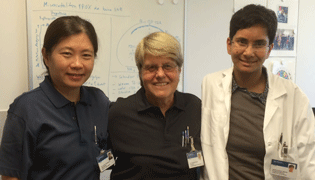Welcome to associate members of the NCCR RNA & Disease
As an effort to enhance the interconnections among Swiss scientists investigating RNA and disease-related problems, the NCCR RNA & Disease offers the possibility for interested group leaders to become associate members. Associate members are invited to NCCR RNA & Disease events, such as retreats and workshops and get access to the technology platforms and programs (e.g. Lab exchange) of the NCCR.
Within the last months, the steering committee has approved 14 requests for associate memberships. Please welcome our new associate members!

Prof. Martine Collart
Department of Microbiology and Molecular Medicine, University of Geneva
My laboratory studies the conserved Ccr4- Not complex in the yeast S.cerevisiae. We are determining which mRNAs are associated with the Not1 scaffold, what the importance of the other subunits for interaction of Not1 with mRNAs is, where the mRNAs are bound and how Not1 association with mRNAs is relevant for their post-transcriptional regulation such as their partitioning between polysomes and RNA granules, their translation or their stability.

Prof. Peter Meister
Institute of Cell Biology, University of Bern
My laboratory is interested in the inter-relationship between cell fate - the execution of a given transcriptional program - and nuclear organization - the spatial folding of the genome inside the nuclear space. We use the nematode C. elegans as a model system for its fixed cell lineage and advanced genetic analysis tools, combining molecular biology (DamID, RNA-seq) and imaging approaches.

Prof. Isabelle Mansuy
Lab of Neuroepigenetics, University/ETH Zürich
My laboratory examines the epigenetic basis of complex brain functions and the heritability of acquired traits across generations in mammals. It uses a mouse model of traumatic stress in early life to study the implication of DNA methylation, non-coding RNAs and histone/protamine modifications in the brain and germ cells in non-genetic transgenerational inheritance.

Dr. Silvia Monticelli
Institute for Research inBiomedicine,Bellinzona
Our lab is interested in the regulation of gene expression, and in particular in molecular networks underlying immunological processes. Over the years we investigated the role of microRNAs, transcription factors and DNA methylation in different immune cells. We are now aiming at understanding the role of microRNAs in regulating human T lymphocyte activation and functional states, both during normal responses to invading pathogens as well as in diseases like autoimmunity.

PD Dr. Torsten Ochsenreiter
Institute of Cell Biology, University of Bern
RNA editing was discovered in trypanosome mitochondria where this mechanism is required to produce functional mRNA transcripts. Similar to the concept of alternative splicing, editing can lead to a diversification of the mRNAs and ultimately to novel protein products. My group is interested in the reg- ulation of this process that involves a large protein complex as well as small non-coding RNAs.

Prof. Vikram Panse
Institute of Biochemistry, ETH Zürich
My laboratory employs a combination of diverse approaches in the model organism budding yeast and structural biology tools to dissect eukaryotic ribosome assembly, quality control and transport. We aim to uncover at the molecular level: (1) How the nucleo-cytoplasmic transport machinery and the ribosome assembly pathway collaborate to build functional ribosomes (2) Quality control steps that permit only correctly assembled ribosomes for translation.

Prof. Olivier Pertz
Department of Biomedicine, University of Basel
We study local mRNA translation in neurons. We have identified a panel of mRNAs that localize to neuronal growth cones. We use live cell imaging techniques to quantitatively study the regulation of mRNA transport, local translation, and the fate of the locally synthesized proteins. This process shapes signaling domains that precisely position cytoskeletal polymers within neuronal processes, or allows for retrograde signaling between the growth cone and the nucleus. This might provide novel therapeutic strategies to target neurodegenerative diseases and neuronal injury.

Dr. Ramesh Pillai
Department of Molecular Biology, University of Geneva (as of early 2016; currently at EMBL Grenoble Outstation, France)
We study how small RNAs protect genomes from mutagenic activity of transposable elements. Gonad-specific ~30 nt PIWI-interacting RNAs (piRNAs) use complementary base-pairing to identify their targets to mediate post-transcriptional or transcriptional repression. Defects in the piRNA pathway lead to infertility in animals due to arrested germ cell development. We use a variety of methods ranging from protein biochemistry to animal genetics, bioinformatics and structural biology.
Key words: PIWI, piRNAs, small RNAs, bio- chemistry, mouse genetics

Prof. Elisabeth I. Minder
Prof. Xiaoye Schneider-Yin
Dr. Jasmin Barman-Aksözen
Institut für Labormedizin, Stadtspital Triemli, Zürich
Our research interest is the rare genetic disorder erythropoietic protoporphyria (EPP), which leads to an extremely painful sensitivity to visible light. EPP is predominantly caused by a splice modulating SNP in combination with a loss of function mutation of the ferrochelatase gene in trans. We aim at correcting the aberrant splicing in EPP-patients, restoring the ferrochelatase level to that of asymptomatic mutation carriers. Together with the NCCR groups of D. Schümperli and J. Hall, we characterize a humanized mouse model, which we developed, and we investigate possibilities to target erythropoietic stem cells.

Dr. Carlo Rivolta
Department of Medical Genetics, University of Lausanne
Our research interests involve the molecular biology and genetics of retinitis pigmentosa (RP), a hereditary disease leading to progressive blindness. In particular, we study the molecular mechanisms by which mutations in a number of pre-mRNA splicing factors, i.e. in proteins that are expressed in all tissues, are evolutionary conserved, and are essential for cell survival in all eukaryotes, can paradoxically cause RP, a tissue-specific, non-deadly condition in humans.

Prof. Mark Robinson
Statistical Bioinformatics Group, University of Zürich
My laboratory at UZH works on methods in statistical bioinformatics. While this brings us close to various types of large-scale genomic data, RNA sequencing data still represents a major theme of our methodological research; at present, we are focused on methods for differential expression, changes in isoform usage and splicing QTL analyses. We collaborate widely with experimental scientists and are always on the lookout for new methodological challenges.

Prof. Isabel Roditi
Institute of Cell Biology, University of Bern
My group investigates how African trypanosomes, the parasites causing human sleeping sickness, regulate gene expression during their life cycle and in response to environ- mental signals. We have a long-standing interest in RNA processing, post-transcriptional control and translation. In addition, we study chromatin-associated proteins and their roles in modulating transcription. Since gene expression in trypanosomes shows marked differences to that of higher eukaryotes, it offers opportunities for therapeutic intervention.

PD Dr. Raffaella Santoro
Institute of Veterinary Biochemistry and Molecular Biology, University of Zürich
A major aim of our research is to define at the mechanistic and functional level the role of long non-coding RNA in epigenetic regulation in human health and disease. How do lncRNAs act? How do their activities integrate into the control of gene expression programs and cell state decision? To address these questions, we use a wide range of approaches by integrating diverse areas including cell biology, biochemistry, molecular biology and bioinformatics.

Prof. Anton Wutz
Institute for Molecular Health Sciences, ETH Zürich
Our research group studies the mechanisms of gene regulation that contribute to establishing the many human cell types. Our research has contributed to understanding the role of RNA in gene regulation during mammalian development. Among the main contribution relevant to NCCR activities is the exploration of the non-coding Xist RNA in regulating chromatin during embryonic development and in cancer cells. We have also addressed the mechanism of gene and chromatin regulation through non-coding RNAs by a number of methods.
Interested in becoming an associate member? Visit our Webpage for more information.